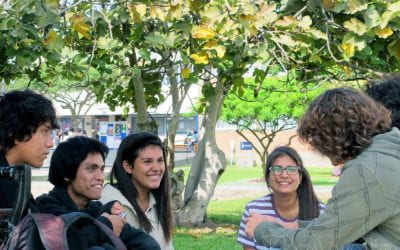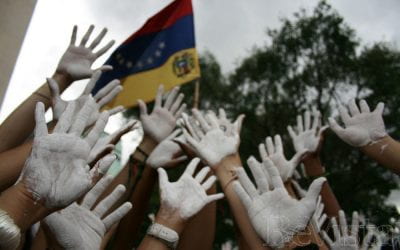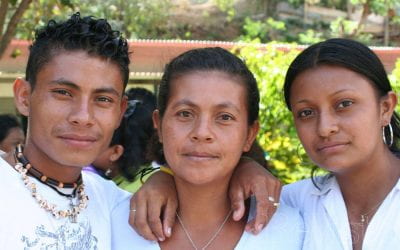Chile’s Student Protests
The Original Sin of Educational Policy

Chilean students protest during Chilean president’s visit to Harvard for fair access to higher education in their homeland. Photo by Maria Barragan Santana.
Less than a decade ago, academics and journalists almost always referred to Chile as a “model” country, praising its economy, political transition and democracy. Always a simplistic characterization, it nonetheless stuck for many years, until the unexpected 2011 explosion of massive student protests and social mobilization. These events have transformed comments on Chilean democracy from praiseful to perplexed, with more questions than answers. How is it that widespread and sustained student mobilizations have broken out in Latin America’s peaceful and prosperous poster child? How did simple protests over student bus fares evolve into a massive social movement challenging not just the educational system, but the country’s entire economic and social model? Why has the government been incapable or unwilling to respond to student demands? Just as the student protests concern much more than the details of educational policy, the answers to these questions require a more realistic evaluation of Chile’s “model” transition and economy. Indeed, the protests are a logical outgrowth of a deal struck at the outset of the transition. Until the terms of that deal are renegotiated, protests will continue.
The more immediate roots of today’s protests can be traced to the 2006 Revolución de los Pingüinos (the Penguins’ Revolution—named for students’ black and white uniforms) that began under the government of Socialist President Michelle Bachelet. She was the last of four presidents heading the
Concertación coalition, which ruled Chile, by most accounts very successfully, since 1990. The protests were sparked by rumors of a price increase for college admissions tests and changes to the highly subsidized student bus pass. The protests quickly escalated into demands for scrapping the
much-hated LOCE, or Organic Education Law, imposed by the Augusto Pinochet regime and an end to the municipality-based educational system it established. More than three-quarters of a million people, from students to parents to other elements of civil society, mobilized in favor of reforms to the deeply unequal dual system of public/private education that characterizes Chile from primary school through higher education.
The protests subsided for several years, less as a result of progress on the educational front than because of the personal popularity of Michele Bachelet and her acumen in managing an economic crisis that threw most of the rest of the world for a loop. However, an end to the Concertación’s twenty-year rule and the right’s first electoral victory in 52 years with the election of President Sebastián Piñera re-opened the floodgates of protest. In a sense, despite the explosion of protests in 2006, the center-left still chafed at protesting “against its own” when it hit the streets during Bachelet’s government. Piñera’s March 2010 inauguration, combined with a number of actions taken by the new government to deepen the privatized educational system, removed this constraint. The protests grew in scope during 2011, returning to and widening the initial demands of the 2006 student leaders.
Once again, the LOCE was the main target at first. After ruling Chile with an iron hand for 17 years, the Pinochet regime shackled Chile legally with a series of organic laws that were difficult to reform. The LOCE was one of these. It provided for a partially privatized system at all levels of education. At the pre-college level it created three tiers: municipal public schools, state subsidized private schools, and completely fee-paying private schools. The latter were largely the province of Chile’s elites. Higher education was even more deeply privatized; 88 percent of higher education institutions in Chile are private and 78 percent of students attend private universities. The state has also ceased to be the major provider of higher education funding. Before the dictatorship, 90 percent of the higher education budget came from the state, while in the post-LOCE era it diminished to only 10 percent, with the remaining costs transferred to individuals. As a result, among 31 European and Latin American countries, Chile has one of the lowest levels of public expenditure on public education.
Privatization also resulted in the proliferation of private universities and technical institutes. While some are of very high quality, a great many are store-front technical institutes designed to enrich their owners. Though all private universities are officially nonprofit, multiple schemes allow university owners to earn money through charging for construction services, building rents or “consulting” fees. Indeed, part of what spurred the initial protests under Piñera were revelations that then Education Minister Joaquín Lavín owned shares in the Universidad del Desarrollo, one such institution.
But more than fighting privatization per se, student protests target its effects. Essentially, Chile has two sets of elite universities: the so-called traditional universities (generally considered the University of Chile and the Catholic University of Chile) and other small, expensive and very exclusive private ones, located outside Santiago and often high up in the posh neighborhoods that wend up the cordillera de los Andes. The social networks that students establish at these universities assure entrance into (or more likely preserve one’s place in) the upper class. Admission is based almost exclusively on the Prueba de Selección Universitaria (PSU) test, Chile’s version of the SAT, generally with a required score of above 600 points. Nonetheless, while fee-paying private high schools graduate only about 10 percent of Chilean students, they make up roughly 60 percent of those that receive this score, meaning that both sets of elite universities are fed by equally elite private high schools. This reality has unleashed a heated discussion on class, classism and the reproduction of privilege in Chile. A very public debate played out in the press regarding the so-called Universidades cota mil (or universities located at an elevation of 1000 meters). Most of the exclusive universities are located here, with new and sophisticated infrastructure and U.S.-style campuses. Some commentators alleged that these universities’ wealthiest students had never been to downtown Santiago. Rather they remained ensconced in exclusive enclaves in the neighborhoods of Las Condes, Vitacura and Lo Barnechea from primary school all the way to college and into their professional and social lives.
The high cost of universities is another target of the protesters. Middle-class families spend 40 percent of their income per child on tuition expenses while children are in college or professional institutes—higher than any other OECD countries, including the United States. This is after spending enormous amounts on private schools up to that point. In Chile, students (and their parents) have to finance most of their education (85.4 percent). This is much above the global average of 31 percent and the OECD average of 24.3 percent. Tuition has increased by 60 percent in current dollars in a decade. These costs, combined with the length of many degree programs (6 to 9 years), have resulted in skyrocketing indebtedness for lower- and middle-class students. When combined with the dismal 50 percent college graduation rate and the difficulties new graduates from non-elite institutions face in finding jobs, students find themselves mired in debt with few opportunities.
Protesters faced these realities anew with Piñera’s victory, though with a different cast than in 2006 in terms of demands, leadership and methods. While demands for ending municipalization and privatization remained, protesters also pressed for greater government financing for public universities and reformed admission standards for prestigious universities, with less emphasis on the PSU. The students wanted accreditation standards tightened and an end to public support for poor quality institutions. They demanded enforcement of the law against profit in higher education, the prosecution of those who use loopholes to get around the prohibition, and an end to the proscription of student participation in university governance. Most central, however, was their demand for free universal education for all Chileans.
The attractive personalities of the leaders appealed to the public eye. The leaders approached the status of pop stars—particularly Camila Vallejo, president of the Student Federation of the University of Chile (FECH). Prominently featured in the New York Times Sunday Magazine and Time, and chosen as the person of the year in an on-line poll of the UK’s Guardian newspaper, she exuded the spirit of Chilean youth culture. Though a Communist, she shunned traditional ideological politics and provided inspiration for expanding student movements across Latin America. Along with the student leader of the Federation of Students of the Catholic University of Chile (FEUC), Giorgio Jackson, and Camilo Ballesteros of the Student Federation of the University of Santiago de Chile (FEUSACH), these young telegenic spokespeople provided an appealing public voice for the students’ demands. The students enjoyed widespread international and domestic support, with invitations to travel around the world, including Vallejo and Jackson going to Europe to speak before UNESCO. Among the Chilean public, support for the student movement more generally approached 80 percent at the height of the protests.
The protesters’ methods also creatively combined the new and the old. The time-tested and traditional cacerolazos (the banging of pots reminiscent of the Salvador Allende era) were resurrected, and these demonstrations were often organized through Twitter. Several creative acts received extensive domestic and foreign media attention, including flash mobs, a zombie walk in front of the La Moneda presidential palace (a metaphor for Chile’s “walking dead” educational system), as well as kiss-ins and a massive “pillow fight for education.” Despite these lighthearted methods, the protests have had serious consequences. Public elementary and high schools and some college departments (facultades) were completely shut down and occupied, and students forced to lose a year of schooling. Massive demonstrations continued, mobilizing up to two hundred thousand demonstrators, with others turning violent. At the height of the protests in August 2011, almost 900 protesters were detained and police cordoned off the streets and used tear gas, with protesters setting fires in the streets and reports of 100 injured police. One student has been killed, and many were injured and arrested.
Protests continued into the 2012 academic year, with growing student determination and intransigence in response to government policy overtures. The Piñera government responded by creating a Superintendence of HigherEducation to oversee and regulate higher education institutions, promised to monitor educational profiteering, lower loan rates, and increase student aid. Still, government efforts fell far short of the students’ demands.
The intransigence on both sides grows from the understanding that the story of educational reform began long ago, at the outset of the democratic transition. The tacit deal that held Chile’s “model” transition together was an agreement to avoid deep reforms to Pinochet’s economic model. Indeed the sanctity of this model was the Achilles heel of the transition, and Concertación politicians knew that reforms that threatened veto players on the right would derail it. Privatized education was one of those areas. So while government officials talk about piecemeal reforms around the edges of the educational system, the protests have become about much more than education. Fundamentally, they are about delayed justice and postponed fairness. Chileans feel that the fruits of the country’s economic success continue to be funneled to the top, within a system rigged to underwrite the continuing power of economic elites. The private educational system is central to how the system is rigged to perpetuate inequality, as just another component of a market model that consistently privileged growth and wealth over equity. This dissatisfaction has also spread to the political system, which is increasingly perceived as unrepresentative and lacking in real competition. Rather than a “model” democracy, Chileans see one characterized by the rotation of elites that are out of touch with the needs and demands of ordinary Chileans.
This does not signal the death knell for Chile’s much vaunted market model, nor an assured victory for the protesters. Rather, the political dynamic operating in Chile is more complex. Though the students continue to enjoy widespread public support, the likelihood of an absolute or definitive victory for either the students or the government is unlikely. While Chileans object to the massive inequality created by the tacit agreement to leave the fundamentals of the Pinochet economic model intact, they really do not question market economics, which are perceived by most to have brought impressive growth and development to the country. While the world is mired in recession, construction cranes dot the Santiago skyline, the economy is dynamic, and the country’s growth remains on target. Rather than throwing away the whole model, Chileans want a social market economy that better distributes the fruits of Chile’s success and ceases to funnel resources mainly to the top.
Indeed, many Chileans doubt the benefits of free universal education. While such a formula might work well in a country with an already level playing field, in a country like Chile, with the highest level of inequality in any country in the OECD, free education might only subsidize education for the rich and may do little to thwart inequality. At a deeper level, the only way for Chile to resolve the current impasse is to atone for the original sin of educational policy that grew out of the democratic transition and to somehow strike a bargain between maximalist demands of students and a negotiated settlement that transforms the educational system from a perpetuator of privilege into an engine for equality.
Fall 2012, Volume XII, Number 1
Peter M. Siavelis is a professor of political science and director of the Latin American and Latino Studies Program at Wake Forest University. He can be reached at siavelpm@wfu.edu.
Related Articles
University Lessons: Editor’s Letter
I learned about universities on the barricades. Well, not exactly. I was a philosophy student at Barnard—the women’s college at Columbia University—when the uprising began in 1968. Students, including my boyfriend and several classmates, took over buildings to protest…
The Last Word
More than twice as many Latin Americans are attending institutions of higher education than two decades ago, and the number will continue to increase as more students graduate from secondary schools. ReVista’s timely focus on higher education is thought-provoking…
Making a Difference: A Problem With the UN Millennium Goals
Every Saturday for two years, Estevana Sánchez walked through the jungle for miles, in the dark, crossing a river in the rainy season, to finish high school. Her five teenage children did the same. At the end of the trail, they took a long bus ride to the town of San Juan del Sur…




